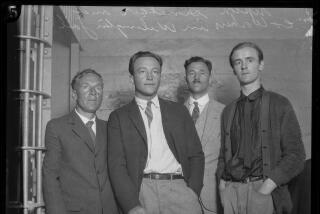Opinion: Why celebrate ‘The Grapes of Wrath’? It’s bad fiction and bad history.
This month marks the 75th anniversary of the publication of “The Grapes of Wrath.” Which means it’s time to trample out the vintage of the Grapes of Mush.
John Steinbeck’s 1939 novel about migrant Central Valley fruit pickers, peopled with robustly two-dimensional characters and dripping like an okra pod with hokey dialog, shameless sentimentality and corn-pone Marxism, is already inflicted by teachers on high school students all over California and elsewhere, along with those two other monuments of preachy mediocre fiction, “The Catcher in the Rye” and “To Kill a Mockingbird.”
But now the torture is escalating. The Contra Costa Times reported that juniors at Northgate High School in Walnut Creek not only had to read “The Grapes of Wrath” as a class assignment but had to participate in a daylong celebration of the dreary journey of Steinbeck’s fictional “Okie” family, the Joads, from their Dust Bowl-blanketed home in Oklahoma to rural California (where the family was ruthlessly exploited by everyone they encountered).
Writing in the Washington Post, Susan Shillinglaw, an English professor at San Jose State University who specializes in Steinbeck studies, went so far as to suggest that we elect Ma Joad, the Joad family matriarch, president. Right, the insufferable Ma Joad (she’s symbolic, so she doesn’t have a first name) -- who oscillates between threatening to bash her menfolk with blunt instruments (“knock you belly-up with a bucket,” “slap ya with a stick a stove wood”) when they don’t do what she wants and serving as a mouthpiece for Steinbeck’s hick-collectivist platitudes: “Maybe if we was all mad in the same way.” Let’s put her in the White House!
“The Grapes of Wrath” is a literary twofer: bad fiction and bad history. The nearly nonexistent story line is a chronicle of lugubrious misery, as the massive Joad family in its overloaded, “Beverly Hillbillies”-style car lurches from one tragic mishap to another on a trek to California that reads as though it takes weeks, if not months -- even though Route 66 was a state-of-the-art highway for its time and the journey could be easily accomplished in from three to six days.
The main reason people think that “The Grapes of Wrath” is a good novel is that in 1940, director John Ford managed to turn it into a first-rate movie, with the help of stellar acting (Henry Fonda as Tom Joad, Steinbeck’s jailbird hero-on-the-lam), haunting chiaroscuro cinematography and the ditching of the novel’s bizarre ending, which features “Rosasharn” breastfeeding a starving man in the spirit of proletarian solidarity. Even in the movie, though, when Tom gives his famous “I’ll be ever’where” speech, I always want to call his parole officer.
Furthermore, Steinbeck got the Okies historically wrong, probably because he himself hailed from an upper-middle-class family in Salinas and his experience with Okies consisted of interviewing a few of them for some newspaper articles. Just for starters, he had the Joads hailing from Sallisaw, in the far eastern part of Oklahoma, even though the Dust Bowl was confined to the state’s western panhandle.
Second, as University of Washington historian James N. Gregory pointed out in “American Exodus,” his magisterial 1989 book about Okie culture in California, many Okies were far from the barely literate rural victims that Steinbeck made them out to be. They were actually part of the huge demographic migration of people from the Southwestern United States to California during the first half of the 20th century in search of better jobs and a better life. Only about half of the Depression-era Okies hailed from rural areas, Gregory pointed out, with the rest coming from towns and cities. Many were white-collar and industrial workers. About half of the Okies, “Arkies” and other Southwesterners settled in Los Angeles, the Bay Area and San Diego and never picked a single crop.
And although there was genuine misery in some of the migrant camps, conditions “were not uniformly horrible,” Gregory wrote. Most Okies found a better standard of living. Many of them also quickly moved out of farm work into better-paying jobs in the oil industry and, when World War II broke out, in the burgeoning Southern California defense plants. By 1950, most Okies had secured comfortable working-class and lower-middle-class lifestyles, and some had downright prospered.
Furthermore -- and here the last laugh is on Steinbeck -- the Okies turned out to be the exact opposite of progressive collectivists, becoming the backbone of California’s political and social conservatism. Instead of fomenting a workers revolution, they led the Reagan Revolution. In “The Grapes of Wrath,” Steinbeck relentlessly mocks the Okies’ Pentecostal Christianity. In fact, their Pentecostal and Baptist churches were a source of moral cohesion. Gregory counted more churches in Bakersfield, where Okie culture influenced everything from spirituality to music, than in San Francisco. To this day, the Okie culture-saturated San Joaquin Valley remains California’s only red-state region.
So, when you think about iconic Okies, don’t think about the chronically immiserated Joads. Think about the Okie multimillionaire car dealer and legendary television personality Cal Worthington. Or that quintessential Okie, Merle Haggard, whose parents who migrated from Checotah in the mid-1930s. Haggard’s classic 1969 hippie putdown, “Okie From Muskogee,” tells you more about what Okies were really like than John Steinbeck ever could.
ALSO:
Will the pro-vaccine celebs please speak up?
Lyft expansion: Good for the sharing economy, bad for everyone else
Forget Donald Sterling and Cliven Bundy; they aren’t today’s Americans
Charlotte Allen writes frequently about feminism, politics and religion. Follow her on Twitter @MeanCharlotte.
More to Read
A cure for the common opinion
Get thought-provoking perspectives with our weekly newsletter.
You may occasionally receive promotional content from the Los Angeles Times.









